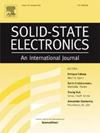微辐射热计用外延p+pn+垂直短二极管
IF 1.4
4区 物理与天体物理
Q3 ENGINEERING, ELECTRICAL & ELECTRONIC
引用次数: 0
摘要
在LWIR波段,pn二极管是微热计中温度计的一个有吸引力的解决方案。本文研究了在303 ~ 343 K下的外延短p+pn+二极管。TCC范围从8%。K−1 ~ 3%。测量了0.2 V ~ 0.8 V之间的K−1和以闪烁噪声为主的电流噪声。最后,在303 K和40 ms的积分时间下,在5.10−11 a和2.10−2 a之间的偏置电流下,获得了5.10−2 K到1.10−4 K的热分辨率。本文章由计算机程序翻译,如有差异,请以英文原文为准。
Epitaxial p+pn+ vertical short diodes for microbolometers
In the LWIR band, pn diodes are an attractive solution for thermometers in microbolometers. In this paper, epitaxial short diodes were studied at 303–343 K. A ranging from 8 %.K to 3 %.K between 0.2 V and 0.8 V and a current noise dominated by flicker noise were measured. Finally, at 303 K and an integration time of 40 ms, a thermal resolution ranging from 5.10 K to K was obtained for bias currents between A and A.
求助全文
通过发布文献求助,成功后即可免费获取论文全文。
去求助
来源期刊

Solid-state Electronics
物理-工程:电子与电气
CiteScore
3.00
自引率
5.90%
发文量
212
审稿时长
3 months
期刊介绍:
It is the aim of this journal to bring together in one publication outstanding papers reporting new and original work in the following areas: (1) applications of solid-state physics and technology to electronics and optoelectronics, including theory and device design; (2) optical, electrical, morphological characterization techniques and parameter extraction of devices; (3) fabrication of semiconductor devices, and also device-related materials growth, measurement and evaluation; (4) the physics and modeling of submicron and nanoscale microelectronic and optoelectronic devices, including processing, measurement, and performance evaluation; (5) applications of numerical methods to the modeling and simulation of solid-state devices and processes; and (6) nanoscale electronic and optoelectronic devices, photovoltaics, sensors, and MEMS based on semiconductor and alternative electronic materials; (7) synthesis and electrooptical properties of materials for novel devices.
 求助内容:
求助内容: 应助结果提醒方式:
应助结果提醒方式:


